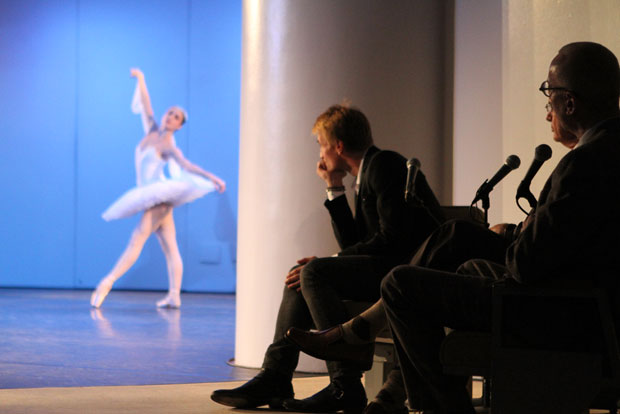
© Jacklyn Meduga. (Click image for larger version)
La Bayadère à la Danoise
Royal Danish Ballet / Works and Process at the Guggenheim
Excerpts from La Bayadère
New York, Guggenheim Museum
22 October 2012
kglteater.dk
www.guggenheim.org
Nikolaj Hubbe interview from December 2009
DanceTabs tag for Royal Danish Ballet
Nikolaj Hübbe and seven of his dancers from the Royal Danish Ballet – including the rising star, Alban Lendorf – stopped by the Guggenheim Museum on Oct. 21-22 to discuss the company’s new production of a La Bayadère, which opens in Copenhagen on Nov. 10. The company has never had a Bayadère, which is not so surprising considering that no-one but the Russians performed the ballet before 1980, when Makarova made her staging for ABT. With his usual boldness Hübbe has decided to change the setting, and with it some of the dynamics of the story. Petipa’s Bayadère was set in a typical nineteenth-century Orientalist fantasy, a mythical India of the distant past in which temple dancers performed fire rites and submitted to (or rejected) the advances of high priests. Hübbe has scrapped that idea and moved the action to the late nineteenth, early twentieth, century, the height of the Raj. Nikiya is still a Hindu temple dancer – or devadasi – but her lover is no longer an Indian warrior, but rather a British officer, Sir William. William’s betrothed (Emma) is now the daughter of a British Vice Consul, not an Indian princess. In effect, William must choose between a white woman of his class, and an Indian woman far below his station. Hübbe has injected both race and colonial politics into the story – it remains to be seen whether the flimsy, fairy-tale plot can sustain such a dose of historical realism.
Complete recording of the Works & Process event – 88 mins in total.
Video streaming by Ustream
Musically it’s not such a stretch. Ludwig Minkus made almost no attempt to alter his compositional style to fit the exotic locale, so the score is filled with waltzes and polkas, not exactly culturally appropriate settings for the dances of harem-girls and fakirs. Hübbe’s betrothal party will take place not in an Indian palace but at a garden party at which the British ladies will be dressed in proper Victorian gowns with boned bodices, by the designer Richard Hudson, the man responsible for the look of Ratmansky’s Nutcracker for ABT (and, of course, The Lion King). The European setting might actually make Minkus’s music-hall score sound less out of character. The famous “Parrot Waltz” – because the ladies carry parrots on their wrists – will be replaced by a dance for six little boys and six little girls from the school, dressed as peacocks with Turkish slippers and brightly-colored, fan-like tails. It sounds adorable.
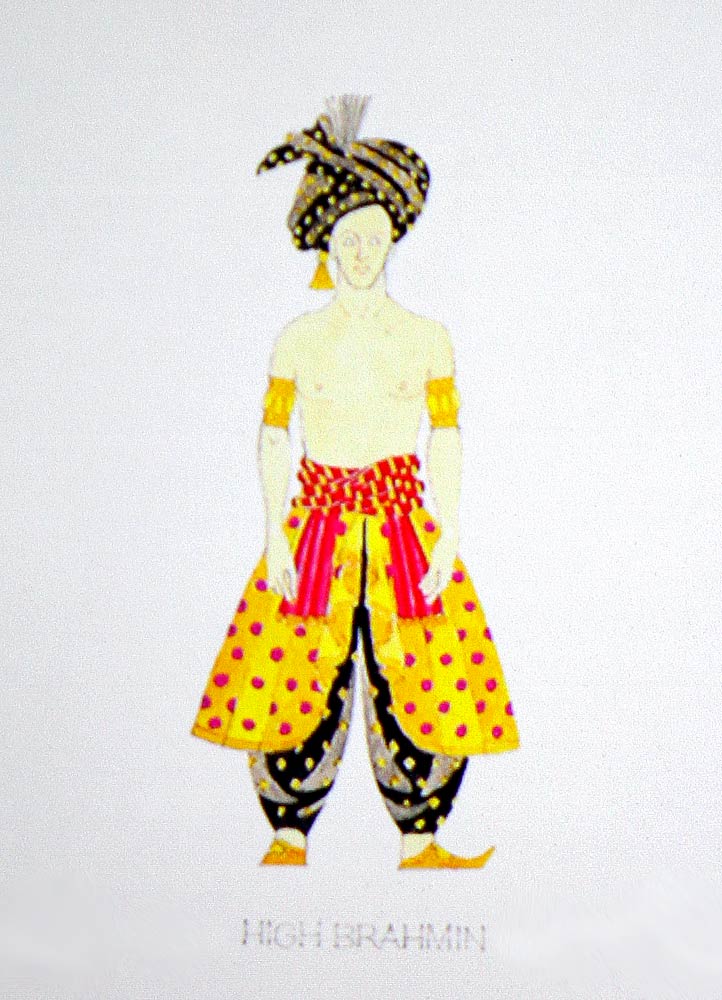
© Jacklyn Meduga. (Click image for larger version)
The Shades Scene is no longer meant to be interpreted as the hero’s opium-fueled dream, but rather as an apotheosis that takes place after the hero’s suicide. The lovers are reunited in heaven and the story ends. Of course, this resolves the pesky problem of the fourth act, in which, originally, the warrior and princess were married, incurring the wrath of the gods and provoking a deadly earthquake. This complicated scenario was excised from Soviet versions of the ballet, and is often left out of more recent stagings, like Nureyev’s for the Paris Opéra. But cutting it leaves the ballet rather unresolved. Why would the story end with an opium dream? By setting the Shades scene after the hero’s death, Hübbe has possibly killed two birds with one stone: eliminated the need for an unwieldy final act and created a sense of closure.

© Jacklyn Meduga. (Click image for larger version)
We shall have to wait for reports from Denmark to find out if this neat solution – betrothal, despair, suicide, apotheosis – makes for a satisfying ending. Hübbe – handsome and captivating as ever in tight black jeans and an Errol Flynn mustache – assured the Works and Process audience that the famously elegiac Shades scene has not been tampered with, though now that I think of it there was some talk of a second ramp to convey the Shades – or spirits – from the heavens to the stage.
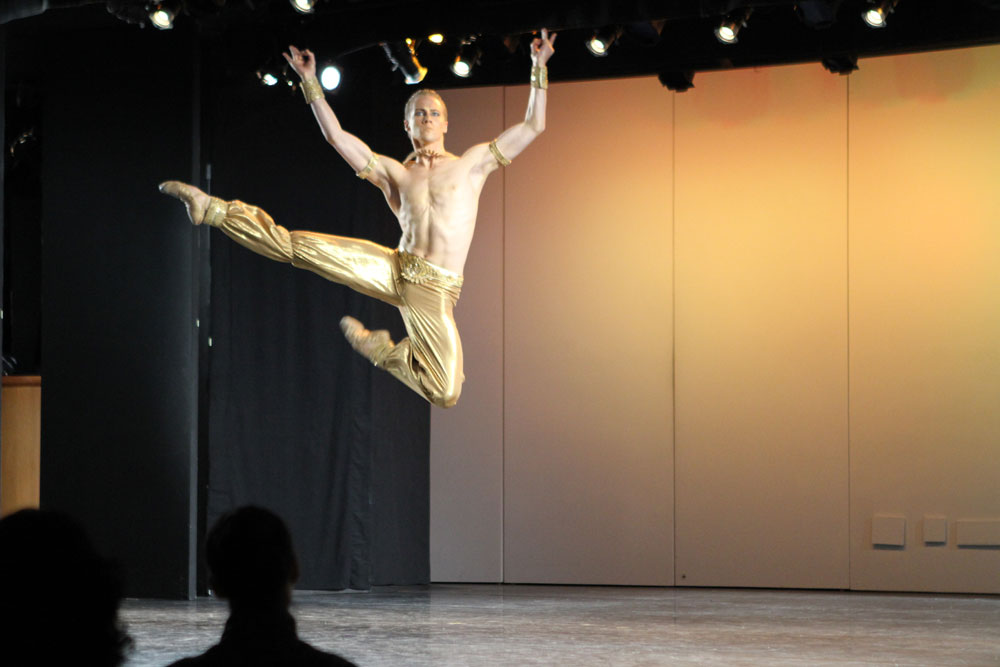
© Jacklyn Meduga. (Click image for larger version)
As performed here, the three Shades variations and the exotic Golden Idol solo did not look very different from what we are used to in New York. They were solidly danced by Jón Axel Fransson (Idol), Holly Jean Dorger, Gitte Lindstrom, and Amy Watson, the later of whom is an American who studied at the School of American Ballet before moving to Denmark. (Unfortunately, I missed final pas d’action because I was anxious to catch the presidential debate.) Will the hyperbolic Russian style of Bayadère suit the demure Danes? It was difficult to tell from the brief excerpts. Nikiya’s first solo, danced impeccably by J’aime Crandall, did not ooze with anything like the sensuality we see in the interpretations of Diana Vishneva or Alina Cojocaru. But that may not be the look Hübbe is going for.
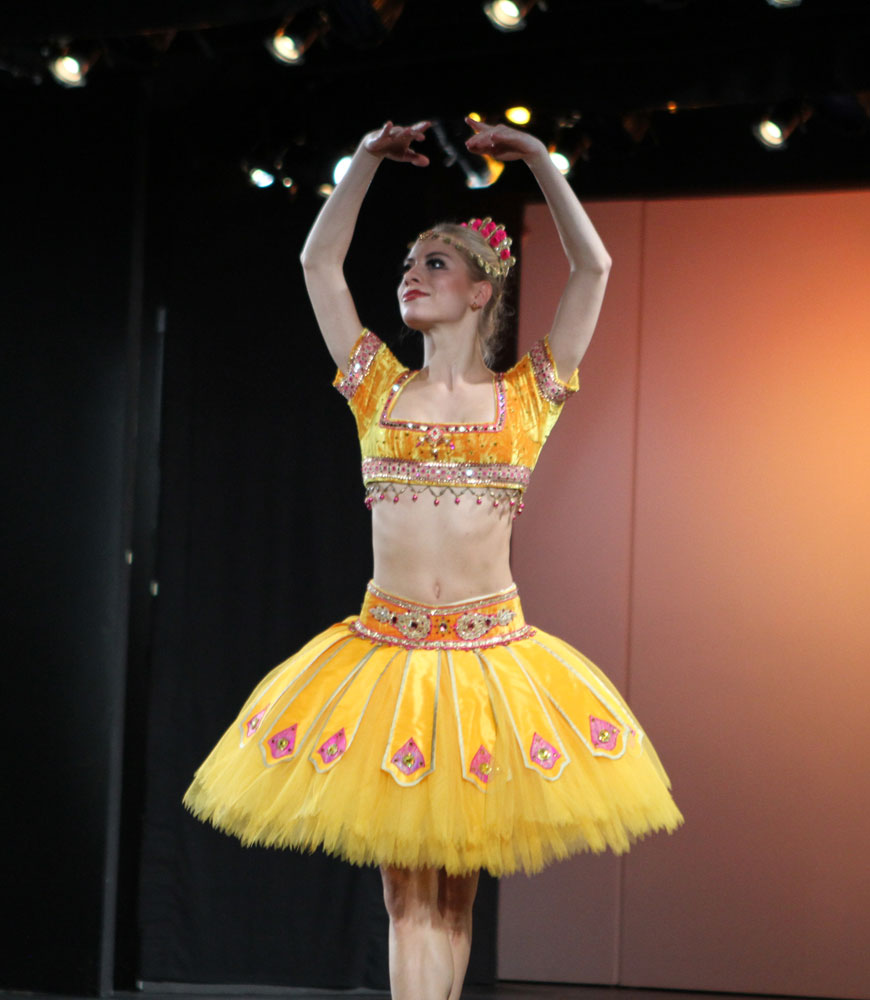
© Jacklyn Meduga. (Click image for larger version)
What one can say is that Hudson’s sets and Bakst-inspired costumes look fetching and fanciful, at least as seen in slides. As with his designs for the second act of Ratmansky’s Nutcracker, the colors are bright: a profusion of yellows, reds, purples, and pinks. The Golden Idol – who, like Nijinsky’s Dieu Bleu, will be blue rather than gold – wears cheerful yellow pantaloons. The Brits will be in drab khaki uniforms – some of them with short trousers – topped by pith helmets. Nikiya will be bare-bellied, with silk pantaloons and a pleated panel between her legs (like the kind Kuchipudi dancers wear) and an asymmetrical, sari-style top. There will be turbans galore – Hudson raved about the Danes’ milliners. He also described the fun of buying fabrics at a marvelous-sounding place called Rainbow Textiles, in Southall (near Heathrow), where, if the owner likes you – and it’s clear she likes Hudson – she leads you down to the basement to dig through her treasures. The set designs, too, are saturated with color and elaborately decorated, but also very flat, like storybook illustrations. Crammed with arches and trimmed with fretwork, they open onto dreamlike vistas of the Himalayas, a perfect setting for the Shades, who, as Karsavina famously said, should appear as “une chaine d’ombres, une brume s’élevant en nuages.” The Danes will have their Bayadère.










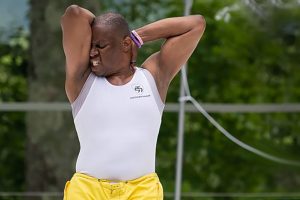




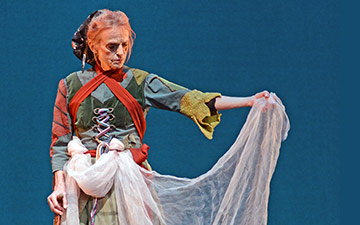
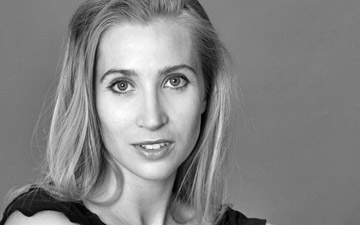
[…] A group of dancers from the Royal Ballet came to Works and Process to discuss and show excerpts from their new production of La Bayadère. I wrote about it for DanceTabs. […]
Just as a follow-up….. There were actually only 6 dancers that traveled from Denmark for the Guggenheim presentation.
Holly jean Dorger is also an American , that studied at the school of American Ballet. Nick Hubbe was one of her instructors. Holly had a Principle part in the 2007 SAB Workshop performance.
No, my mistake. There were 7 dancers.
My apologies.
The “unknown” Shade in the first picture is Amy Watson, Principle Dancer, Royal Danish Ballet 🙂
‘The “unknown” Shade in the first picture is Amy Watson’ – Thanks for letting everybody know. Sadly there were no captions with any of the pictures as received. But it is a great picture.
[…] Ballet performed excerpts at the Guggenheim museum in New York City to stir excitement ~ Click here for a review and the full streaming of their show […]
[…] https://www.dancetabs.com/2012/10/works-process-at-the-guggenheim-royal-danish-ballets-new-la-bayader… […]